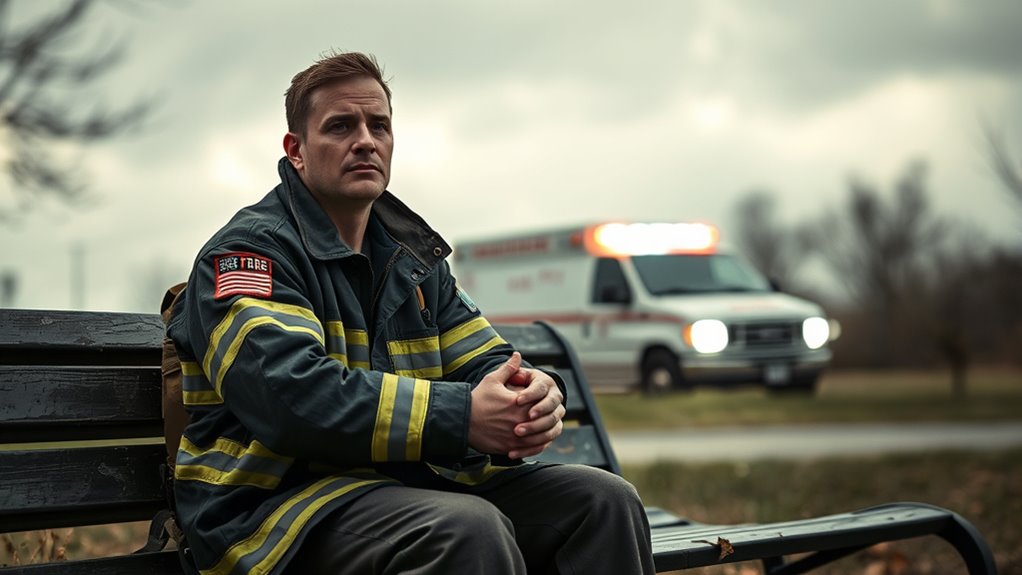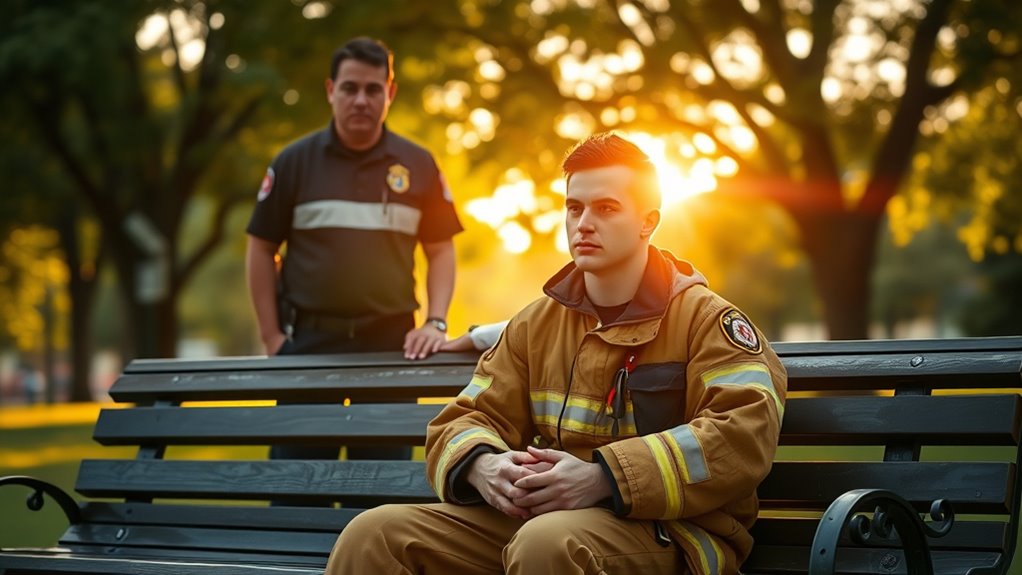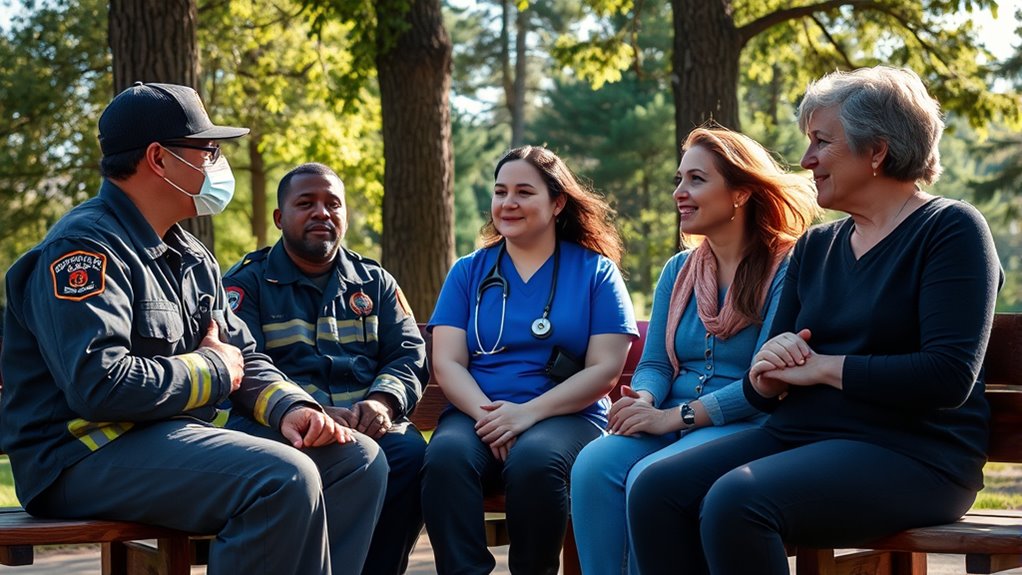To address PTSD in first responders and survivors, recognize the signs like flashbacks, nightmares, and emotional numbness, and understand the unique stresses they face after repeated trauma. Support networks, peer programs, and community efforts help reduce feelings of isolation and promote healing. Effective strategies include counseling, mindfulness, and trauma-informed care, all aiming to build resilience and reduce stigma. If you want practical ways to foster recovery and support, there’s more to explore.
Key Takeaways
- Recognize early signs of PTSD, such as flashbacks and emotional numbness, to facilitate timely intervention.
- Promote mental health education to reduce stigma and encourage help-seeking among first responders and survivors.
- Establish community and peer support networks to provide safe spaces for sharing and emotional resilience.
- Implement trauma-informed care and accessible counseling, including debriefings and virtual services, to support recovery.
- Use holistic therapies like mindfulness, cognitive restructuring, and creative methods to enhance long-term mental health.
Recognizing the Signs and Symptoms of PTSD

Understanding the signs and symptoms of PTSD is essential for early identification and intervention. As a first responder or survivor, you might notice flashbacks, nightmares, or emotional numbness—clear indicators of PTSD. Recognizing these signs early helps leverage veteran resilience, enabling you to seek support before symptoms worsen. Changes in mood, difficulty concentrating, or heightened irritability can also signal distress. Effective crisis communication plays a crucial role in addressing these symptoms, encouraging open dialogue about mental health struggles. By understanding and acknowledging these signs, you can take proactive steps toward recovery. Remember, early recognition fosters resilience and opens pathways to professional help, making the journey toward healing more manageable. Your awareness can make a significant difference in managing PTSD symptoms. Additionally, understanding how PTSD affects mental health can guide more targeted and effective support strategies. Being aware of trauma responses can help you distinguish between normal stress reactions and symptoms requiring professional intervention. Recognizing the importance of early intervention is vital for preventing long-term mental health challenges associated with PTSD. Developing coping strategies can also empower individuals to manage symptoms more effectively and build resilience over time. Furthermore, engaging in mindful practices can support emotional regulation and recovery.
Understanding the Unique Challenges Faced by First Responders and Survivors

Understanding these challenges is key to finding effective support and overcoming barriers to recovery. Recognizing the ethical concerns surrounding mental health in high-stress professions can also influence how organizations implement support systems. Additionally, awareness of the prevalence of gaslighting tactics and their impact on mental health can help organizations develop targeted interventions. Creating a comfortable environment, such as a calming and supportive space, can also significantly aid in the healing process for survivors and first responders. Incorporating environmental considerations like safe and private spaces ensures that mental health support minimizes additional stressors. Utilizing evidence-based strategies, such as trauma-informed care, can further improve outcomes for those affected.
Trauma Exposure Risks
First responders and survivors face unique trauma exposure risks that set their experiences apart from the general population. Your job exposes you repeatedly to traumatic events, increasing the risk of developing PTSD. Occupational hazards such as accidents, violence, and disasters are common in your line of work, heightening your exposure frequency. This constant exposure can lead to emotional exhaustion and mental health challenges if not managed properly. The nature of your duties means you often encounter life-threatening situations or scenes with severe injuries, intensifying the trauma. Over time, the cumulative effect of these experiences can take a toll on your well-being. Recognizing these unique trauma exposure risks is essential for developing effective prevention and recovery strategies tailored to your needs. Incorporating continuous training and support can help mitigate some of these risks and promote resilience. Additionally, understanding the importance of support systems can significantly enhance recovery and mental health outcomes for those affected, especially when combined with self-care practices that address burnout and stress. Staying informed about trauma-informed care approaches is also crucial for improving overall well-being and resilience in high-stress situations. Moreover, managing stress responses effectively can help reduce the long-term impact of repeated trauma exposure.
Cultural Stigma Barriers
Cultural stigma surrounding mental health often prevents first responders and survivors from seeking help or openly discussing their struggles. Many believe admitting to emotional difficulties signals weakness, which hampers stigma reduction efforts. To break down these barriers, fostering cultural awareness is essential. When you understand the unique challenges faced by first responders, you can create a supportive environment that encourages openness. Recognizing that mental health issues are common and treatable helps reduce shame and silence. Promoting education and normalizing conversations about PTSD can shift perceptions, making it easier for individuals to seek help without fear of judgment. Addressing cultural stigma directly empowers first responders and survivors to access the support they need for recovery and resilience. Incorporating emotional impact techniques in outreach and education initiatives can further enhance understanding and empathy among peers and the community. Additionally, understanding flushing mechanisms and efficiency can inform better practices in everyday situations, helping to prevent issues like clogs and leaks that can cause frustration and additional stress. Developing a growth mindset around mental health can also encourage individuals to view challenges as opportunities for learning and resilience, fostering a more accepting culture.
Effective Strategies for Supporting Mental Health in Emergency Services

Implementing peer support programs, providing access to professional counseling, and conducting post-event debriefings are key strategies to support mental health in emergency services. These approaches help responders process their experiences and reduce stigma around seeking help. By prioritizing these strategies, you can create a healthier, more resilient workforce. Incorporating self-care practices and mental health trends into training can also enhance awareness and early intervention efforts. Additionally, fostering an understanding of spiritual energy and its influence on emotional well-being can provide a holistic approach to recovery. Recognizing the role of textile art techniques in therapeutic settings can offer alternative methods for emotional expression and healing. Emphasizing the use of generative AI in entertainment can also be explored to develop engaging educational content on mental health awareness.
Peer Support Programs
Have you ever wondered how peer support programs can effectively bolster mental health for emergency responders and survivors? These programs rely on peer mentorship, where colleagues share experiences and offer understanding, creating a safe space for emotional expression. Support networks foster a sense of belonging, reducing feelings of isolation common after traumatic incidents. By connecting individuals with others who have faced similar challenges, peer support programs encourage open dialogue and mutual encouragement. This approach not only normalizes mental health struggles but also promotes resilience. You’ll find that peer mentorship helps responders process their experiences more effectively and develop coping strategies. Overall, these support networks serve as a crucial supplement to formal mental health services, empowering emergency personnel to seek help and build stronger psychological resilience. With proper implementation, these programs can significantly improve mental health outcomes and reduce stigma around mental health. Incorporating peer support into existing mental health strategies can enhance overall effectiveness and sustainability.
Professional Counseling Access
Access to professional counseling is a vital component of supporting mental health for emergency responders and survivors. When counseling accessibility is prioritized, individuals are more likely to seek help early and consistently. Ensuring therapist availability means reducing wait times and offering flexible schedules that fit demanding shifts. To improve access, consider these strategies:
- Provide on-site or virtual counseling options for immediate support
- Increase the number of trained mental health professionals familiar with emergency response needs
- Promote confidentiality to reduce stigma and encourage utilization
Post-Event Debriefings
Post-event debriefings serve as a vital follow-up to professional counseling by providing a structured opportunity for responders and survivors to process their experiences. During these sessions, you can openly share your feelings and reflections, which fosters emotional processing and reduces the risk of unresolved trauma. Effective post event debriefings help clarify what happened, normalize emotional reactions, and reinforce support networks. They also enable you to identify potential mental health concerns early, encouraging timely intervention. By actively participating in debriefings, you take control of your emotional recovery and build resilience. Remember, these sessions are not about dwelling on the negative but about understanding and coping with your experiences. When done properly, post-event debriefings strengthen mental health and foster a sense of community and shared healing.
The Role of Community and Peer Support in Recovery

Community and peer support play a crucial role in helping first responders and survivors recover from PTSD by fostering a sense of understanding and belonging. When you participate in community mentorship or peer-led initiatives, you gain access to shared experiences and practical advice that normalizes your feelings. These programs create safe spaces where you can express vulnerability without judgment, strengthening resilience.
Community support creates safe spaces that normalize feelings and build resilience for first responders and survivors.
Some key benefits include:
- Building trust through relatable role models
- Reducing feelings of isolation
- Enhancing motivation to seek ongoing support
Engaging in peer support helps you realize you’re not alone in your journey. It empowers you to take active steps toward healing while feeling connected to a community that understands your struggles. This collective approach is essential for sustainable recovery from PTSD.
Professional Treatment Options and Therapeutic Approaches

Professional treatment options and therapeutic approaches are essential for effectively managing PTSD in first responders and survivors. These methods help you process trauma, reduce symptoms, and regain control. Mindfulness therapy teaches you to stay present and observe your thoughts without judgment, easing anxiety and emotional distress. Cognitive restructuring helps you challenge and reframe negative thoughts linked to trauma, promoting healthier thinking patterns. Consider the following options:
| Therapy Type | Focus |
|---|---|
| Mindfulness Therapy | Present-moment awareness, emotional regulation |
| Cognitive Restructuring | Changing negative thought patterns |
| Exposure Therapy | Gradual confrontation of trauma memories |
These approaches empower you to build resilience and foster recovery, leading to a healthier, more balanced life.
Building a Culture of Resilience and Reducing Stigma

Building a culture of resilience and reducing stigma requires proactive efforts that encourage open dialogue and foster support. When you prioritize workplace resilience, you create an environment where individuals feel safe sharing struggles without fear of judgment. Stigma reduction starts with leadership openly addressing mental health, normalizing conversations around PTSD and stress. To strengthen this culture, consider these steps:
Prioritize open dialogue and leadership support to build resilience and reduce mental health stigma at work.
- Promote mental health awareness programs that educate and destigmatize seeking help
- Implement policies that support work-life balance and mental well-being
- Foster peer support networks that encourage shared experiences and mutual encouragement
Frequently Asked Questions
How Can Organizations Proactively Prevent PTSD Among First Responders?
You can proactively prevent PTSD among first responders by implementing preventive training that teaches coping skills and resilience. Encourage peer support programs, so responders feel comfortable sharing experiences and seeking help. Regular mental health check-ins also help identify issues early. Creating a supportive environment diminishes stigma, fosters open communication, and ensures responders get the help they need before symptoms escalate, ultimately protecting their mental well-being.
What Are the Long-Term Effects of Untreated PTSD on Survivors?
Imagine a survivor who leaves an incident feeling numb, only to face years of untreated PTSD. Over time, you might see chronic physical health issues like heart problems and persistent fatigue. Social relationships can deteriorate as they withdraw from loved ones, feeling misunderstood or overwhelmed. Without treatment, these long-term effects deepen, making recovery harder and impacting their overall quality of life.
How Do Cultural Differences Impact PTSD Treatment Acceptance?
You’ll find that cultural differences profoundly influence PTSD treatment acceptance. Cultural stigma often makes individuals hesitant to seek help, fearing judgment or shame. Treatment disparities arise when certain groups have less access to mental health services or different beliefs about mental health care. Recognizing these barriers helps you tailor approaches that respect cultural values, encouraging more survivors to pursue effective treatment and ultimately improving recovery outcomes.
Can Technology Assist in Monitoring Mental Health in Emergency Personnel?
Imagine wearing a sleek device that gently tracks your heartbeat and stress levels throughout your shift. Wearable sensors and AI diagnostics work behind the scenes, providing real-time insights into your mental health. This technology helps you recognize early signs of distress, enabling timely intervention. By seamlessly integrating into your routine, it offers a proactive approach, ensuring you stay resilient and supported during even the most demanding emergency responses.
What Policies Support Sustainable Mental Health Practices in Emergency Services?
You should focus on policies that promote peer support and mental wellness programs, as these foster a supportive environment for emergency personnel. Implementing regular training, encouraging open communication, and providing access to counseling help sustain mental health practices. You can also advocate for organizational commitments that prioritize mental wellness, ensuring that responders feel valued and supported, leading to long-term resilience and better overall mental health in emergency services.
Conclusion
By recognizing the signs, supporting each other, and embracing professional help, you can turn the storm of PTSD into calmer waters. Remember, resilience is a muscle you build every day, and no one has to face this challenge alone. With community, understanding, and ongoing care, you can find hope shining through the darkest clouds. Together, you’re stronger than the shadows—ready to heal and reclaim your peace.










